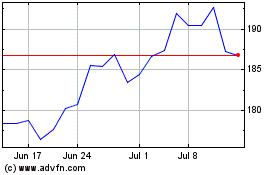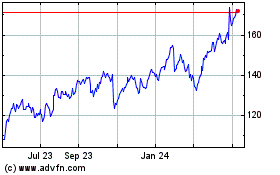Google Doubles Down on Nexus to Keep Up With Apple -- Update
September 29 2015 - 1:37PM
Dow Jones News
By Alistair Barr
Google Inc. is doubling down on its Nexus program to gain more
control over its Android mobile-operating system as new technology
and rising competition from Apple Inc. highlight the value of
integrating software and hardware.
On Tuesday, Google launched two Nexus phones simultaneously for
the first time since the program began in 2010. The devices, made
by LG Electronics Inc. and China's Huawei Technologies Co., have
fingerprint sensors that support a new Android Pay mobile-payment
service.
The devices also feature a new Android Sensor Hub that processes
sensor data. A low-power sensor from Robert Bosch GmbH helps the
phones determine if users are walking, running or biking, and can
count steps. Most of the features follow similar iPhone
capabilities.
"With Nexus, we try to push Android forward. So we build
hardware along with ecosystem partners. This year we've gone a step
further," incoming Google CEO Sundar Pichai said during an event
Tuesday unveiling the two new Nexus phones.
Apple designs its own hardware and software, so it is well
placed to develop these features. Google, by contrast, authors
Android software but primarily lets other companies, such as
Samsung Electronics Co. and Lenovo Group Ltd., manufacture the
phones. That makes integrating such features more difficult.
The Nexus program is designed to help bridge that gap. When
Google develops a new version of Android, it chooses a handset
maker, or two, with which it works closely on new hardware, as a
showcase for other phone makers. The latest version of Android,
Marshmallow, launched Tuesday with the new Nexus phones.
As smartphones blend the digital and physical worlds through
services like paying in stores, integrating hardware and software
grows more important.
"It's a counterbalance to Apple's vertically integrated
approach," said Rajeev Chand, head of research at Rutberg &
Co., an investment bank focused on the mobile industry. "Nexus
devices are the only ones that Google can control end-to-end."
Google doesn't seek blockbuster sales of Nexus phones. Instead,
it hopes that the Nexus models demonstrate the value of Google's
latest innovations, so other handset makers will adopt them.
"Nexus is a way for us to prove out the software and hardware
integration and drive these kinds of innovations across Android,"
said Hiroshi Lockheimer, head of Android.
Some handset makers are eager to work with Google on Nexus
phones to gain insight into how to integrate new Android features
into their phones, said Kevin Packingham, former chief product
officer at Samsung. He cited Samsung's Galaxy S3 phone, which made
its debut in 2012, as having benefited from Samsung's earlier
involvement in Nexus.
Google introduced "widgets" on the Nexus 4 phone in 2012. These
app icons update with new information like stock prices or weather
forecasts without users taking action. Handset makers had worried
that the updates would drain phone batteries, but they adopted the
widgets after Google proved with the Nexus 4 that they could work,
Mr. Packingham said.
This doesn't always go according to plan. Handset makers and
wireless carriers are often slow to update Android devices to new
versions of the operating system. That means new features take time
to reach all users.
Lollipop, the version of Android that Google launched with the
Nexus 6 phone in late 2014, is installed on only 21% of Android
devices, according to the company.
"There's some level of frustration at Google with carriers and
OEMs that don't innovate as quickly as they should," said Colin
Sebastian, an analyst at RW Baird. "This is even more important,
given how competitive the smartphone market is with Apple."
Write to Alistair Barr at alistair.barr@wsj.com
Subscribe to WSJ: http://online.wsj.com?mod=djnwires
(END) Dow Jones Newswires
September 29, 2015 13:22 ET (17:22 GMT)
Copyright (c) 2015 Dow Jones & Company, Inc.
Alphabet (NASDAQ:GOOG)
Historical Stock Chart
From Mar 2024 to Apr 2024

Alphabet (NASDAQ:GOOG)
Historical Stock Chart
From Apr 2023 to Apr 2024
